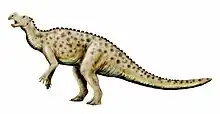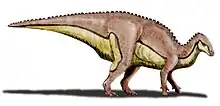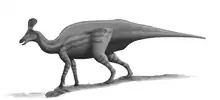| Theiophytalia Temporal range: Early Cretaceous, | |
|---|---|
 | |
| Holotype skull, white parts are reconstructed | |
| Scientific classification | |
| Domain: | Eukaryota |
| Kingdom: | Animalia |
| Phylum: | Chordata |
| Clade: | Dinosauria |
| Clade: | †Ornithischia |
| Clade: | †Ornithopoda |
| Clade: | †Styracosterna |
| Genus: | †Theiophytalia Brill & Carpenter, 2006 |
| Species: | †T. kerri |
| Binomial name | |
| †Theiophytalia kerri Brill & Carpenter, 2006 | |
Theiophytalia is a genus of herbivorous iguanodontian dinosaur from the lower Cretaceous period (Aptian-Albian stage, about 112 million years ago[1]) of Colorado, USA. It contains a single species, T. kerri.[2]
Description

Detailed comparisons by Brill and Carpenter (2006) also showed that the skull differed in a number of key features from that of Camptosaurus, namely: a longer, heavier, and more rugose snout; a wider dorsal process on the maxilla; a proportionally smaller antorbital fenestra; and stouter quadrate, with a bulbous articulation for the lower jaw. Compare the skull image with that of Camptosaurus. Therefore, they put it into its own genus and species.[2]
Discovery

In 1878, a student of Colorado College named James Kerr found a partial ornithopod skull at Garden of the Gods park in El Paso County, Colorado.[2] The skull, YPM 1887, was referred by O.C. Marsh (affirmed by Gilmore, 1909), to whom the skull was given in 1886, as that of Camptosaurus amplus. Gilmore used the skull to reconstruct the skull of Camptosaurus assuming that it came from the Morrison Formation.[3] However, microscopic comparisons of thin-sections of the Mesozoic formations in the Garden of the Gods showed that the specimen actually came from the Lytle Member of the Purgatoire Formation; therefore, the skull was Early Cretaceous in age.
The generic name is, from Greek, θειος, theios: "divine" + Greek φυταλία, phytalia: "garden", or "garden of the gods". Garden of the Gods is a park in Colorado Springs, Colorado, where a skull, the only fossil of the genus yet to be discovered, was found in 1878. The specific name kerri honors James Hutchinson Kerr, who found the specimen.[2]
Classification
The article describing the find classified Theiophytalia as intermediate in derivation between Camptosaurus and Iguanodon. The type species is Theiophytalia kerri.[2] In 2010 and 2011 cladistic analyses of McDonald and colleagues, Theiophytalia has been recovered as a basal member of the Styracosterna and its closest relative was Hippodraco.[4][5]
| Ankylopollexia |
| ||||||||||||||||||||||||||||||||||||||||||||||||
References
- ↑ Carpenter, K. & Ishida, Y. (2010). "Early and "Middle" Cretaceous Iguanodonts in Time and Space" (PDF). Journal of Iberian Geology. 36 (2): 145–164. doi:10.5209/rev_JIGE.2010.v36.n2.3.
- 1 2 3 4 5 Brill, K. & K. Carpenter (2006). "A Description of a New Ornithopod from the Lytle Member of the Purgatoire Formation (Lower Cretaceous) and a Reassessment of the Skull of Camptosaurus". In Carpenter, Kenneth (ed.). Horns and Beaks: Ceratopsian and Ornithopod Dinosaurs. Bloomington: Indiana University Press. pp. 49–67.
- ↑ Gilmore, C.W. (1909). "Osteology of the Jurassic reptile Camptosaurus, with a revision of the species of the genus, and descriptions of two new species". Proceedings of the United States National Museum. 36 (1666): 197–332. doi:10.5479/si.00963801.36-1666.197.
- ↑ McDonald, A.T.; Kirkland, J.I.; DeBlieux, D.D.; Madsen, S.K.; Cavin, J.; Milner, A.R.C. & Panzarin, L. (2010). "New Basal Iguanodonts from the Cedar Mountain Formation of Utah and the Evolution of Thumb-Spiked Dinosaurs". PLOS ONE. 5 (11): e14075. Bibcode:2010PLoSO...514075M. doi:10.1371/journal.pone.0014075. PMC 2989904. PMID 21124919.
- ↑ Andrew T. McDonald (2011). "The taxonomy of species assigned to Camptosaurus (Dinosauria: Ornithopoda)" (PDF). Zootaxa. 2783: 52–68. doi:10.11646/zootaxa.2783.1.4.







